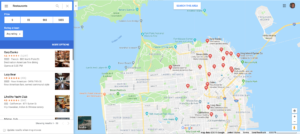 Local SEO is a specialized kind search engine optimization – it allows you to be found by prospects who are most likely to walk in your front door; people who are searching for you specifically and people who are searching for what you do and sell nearby them.
Local SEO is a specialized kind search engine optimization – it allows you to be found by prospects who are most likely to walk in your front door; people who are searching for you specifically and people who are searching for what you do and sell nearby them.
Think about it; there are thousands of potential customers near your store who have no idea that you’re right there in the neighborhood with exactly what they need.
Success in Local SEO is driven by the closely matched results from Google and Google Maps; their focus is to deliver the most relevant and useful results to the searcher – geography is an important part of that relevance and maps can get you a spot on the coveted “Page One of Google”.
is to deliver the most relevant and useful results to the searcher – geography is an important part of that relevance and maps can get you a spot on the coveted “Page One of Google”.
Make sure you’re optimized with this simple, 5 Step LOCAL SEO Checklist:
- GMB – Google My Business. Google pulls together all the information it can about your business from
 the web – search, maps, the remnants of Google+, you can control much of these results by using “Google My Business”. Make sure you’ve claimed your business and then fill it in with accurate, consistent information (more on that next), make sure your address is in the town you’re focused on and your location is owner-verified (they will robo-call or send a post card to prove it’s you) and insure the categories you list on GMB are consistent with the offers and info on your website.
the web – search, maps, the remnants of Google+, you can control much of these results by using “Google My Business”. Make sure you’ve claimed your business and then fill it in with accurate, consistent information (more on that next), make sure your address is in the town you’re focused on and your location is owner-verified (they will robo-call or send a post card to prove it’s you) and insure the categories you list on GMB are consistent with the offers and info on your website. - Check Your NAP. Name, Address, Phone; this is the low hanging fruit and many businesses are sloppy here; make sure the contact information you post online is consistent across the board; business name, address and phone number must ALWAYS be the same. Make a template listing that you can cut and paste into GMB … and every other listing or directory you can find (like your Local Chamber Directory, Yelp or BBB)
- Get the MAP. Besides the basic contact info, include a map on your site with your precise location and be sure to include; store hours, directions (including landmarks) and make it easy to get to you with a “Call Now” link and social media links so they can connect that way if they prefer.

- Make Search Specific Pages. You’ll want a page specifically for each location, with a headline, copy and photos about that location and you’ll want to make sure you have a distinct product or service page (this is also important when running ads; you want to take people to the specific page where they can learn more about (and purchase) the thing you’re advertising (vs. dropping them to your home page and letting them figure it out from there) this gives your prospect a better experience and gives you better search results (yes, Google follows the links to make sure you’re selling what you’re promoting).
- Get Good Reviews. Google takes reviews seriously, it helps them determine just how deserving you are of a recommendation – or top spot in the results. The reviews that show up most prominently are from Google itself, Yelp and Facebook – often the best way to get reviews is to ask for them, casually.
 People who are reviewers will likely respond well to a prompt after a great experience. A simple ‘YelpUs’ sign by the register or featuring positive reviews in your social media marketing will do the trick. Do not hassle people to do it, have your employees write reviews or (heaven forbid) do fake ones yourself. It’s cheating, poor form and you’ll likely get dinged by the site.
People who are reviewers will likely respond well to a prompt after a great experience. A simple ‘YelpUs’ sign by the register or featuring positive reviews in your social media marketing will do the trick. Do not hassle people to do it, have your employees write reviews or (heaven forbid) do fake ones yourself. It’s cheating, poor form and you’ll likely get dinged by the site.
These 5 steps will give you a jumpstart for your Local SEO – these are the basics, once you’ve got these squared away you can expand your focus to inbound links rom relevant sites, citations and listings from every online directory feasible and using simple videos to reinforce your value to shoppers in the neighborhood.
Start with these steps to set yourself up for the win in Local Search!
When you’re ready to dig into the details, there are some very useful Local SEO tools at MOZ